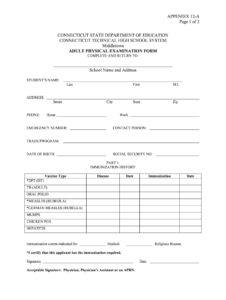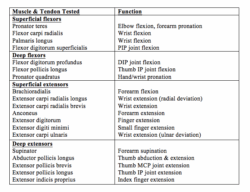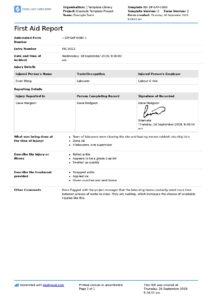Navigating the world of medical documentation can feel like traversing a complex maze. When it comes to tendon exams, having a structured and readily available tendon exam template documentation is not just helpful, it’s essential. It streamlines the process, ensures consistency, and ultimately contributes to better patient care. Imagine the time saved and the clarity gained by having a well-defined framework to guide you through each examination.
Think about the frustration of trying to recall specific details weeks or months after an examination. A solid tendon exam template documentation acts as a reliable memory aid, enabling you to accurately track patient progress and make informed treatment decisions. This becomes especially crucial when collaborating with other healthcare professionals or when dealing with legal or insurance-related matters.
But where do you start? What elements should be included in your ideal template? How can you ensure that it is both comprehensive and user-friendly? This article will explore the key components of an effective tendon exam template documentation, offering guidance on creating a valuable resource that will enhance your clinical practice.
Crafting a Comprehensive Tendon Exam Template
Developing a robust tendon exam template requires careful consideration of the specific information you need to gather during the examination. It should be structured in a logical manner, allowing for easy navigation and efficient data entry. Consistency is key here; a standardized template ensures that all relevant aspects of the exam are consistently assessed and documented across different patients and over time.
The core of your tendon exam template should revolve around the anatomical location of the tendon being examined. For example, if you are evaluating the Achilles tendon, the template should include sections for palpation, range of motion testing (dorsiflexion and plantarflexion), and assessment of pain with resisted movement. Specific tests, such as the Thompson test for Achilles tendon rupture, should also be included as appropriate.
Beyond the physical examination findings, it’s important to incorporate sections for patient history and subjective complaints. This includes information on the onset of symptoms, any previous injuries or treatments, and the patient’s pain level using a standardized pain scale. Detailing the patient’s functional limitations and their impact on daily activities provides valuable context for the examination findings.
Don’t forget to include a section for special tests relevant to the specific tendon. For instance, when evaluating the rotator cuff tendons, the template should include spaces to document the results of tests like the Neer impingement test, Hawkins Kennedy test, and empty can test. These tests help to differentiate between different types of tendon pathology.
Finally, the template should have a designated area for your assessment and plan. This is where you synthesize the information gathered during the examination and formulate a diagnosis. Your plan should outline your proposed treatment strategies, including specific exercises, modalities, or referral recommendations. Consider including a section for follow-up appointments and objective measures to track progress over time.
Key Elements for an Effective Template
While the specific content of your tendon exam template will vary depending on your practice and the types of patients you see, certain elements are universally beneficial. These include:
- Patient Demographics: Name, date of birth, medical record number.
- Date and Time of Exam: Essential for tracking changes over time.
- Chief Complaint: A brief description of the patient’s presenting problem.
- History of Present Illness: A detailed account of the patient’s symptoms.
- Past Medical History: Relevant medical conditions that may impact tendon health.
- Medications: A list of current medications.
- Allergies: Documented allergies.
- Physical Examination Findings: Palpation, range of motion, strength testing, special tests.
- Assessment: Your diagnosis based on the examination findings.
- Plan: Your proposed treatment strategies.
Benefits of Using a Standardized Template
The advantages of adopting a standardized tendon exam template extend beyond simple time-saving. It promotes thoroughness, reduces the risk of overlooking important details, and enhances communication between healthcare providers. Imagine the peace of mind knowing that every aspect of the tendon examination is consistently addressed and documented.
Consistency is paramount in clinical practice. A well-designed template ensures that each patient receives a comprehensive and uniform evaluation. This uniformity makes it easier to track patient progress over time and compare results across different examinations. This consistency is not only beneficial for patient care but also for research purposes, enabling the collection of standardized data for analysis.
Improved communication is another significant benefit. When multiple healthcare providers are involved in a patient’s care, a standardized template facilitates clear and concise communication of examination findings. This reduces the risk of miscommunication and ensures that everyone is on the same page regarding the patient’s condition and treatment plan. The template serves as a common language, fostering collaboration and teamwork.
Furthermore, utilizing a tendon exam template documentation strengthens your legal protection. Accurate and complete documentation is crucial in defending against potential malpractice claims. A well-structured template demonstrates that you have followed a systematic approach to patient evaluation and have thoroughly documented all relevant findings. This can be invaluable in the event of a legal challenge.
Finally, implementing a tendon exam template can lead to increased efficiency and reduced administrative burden. By streamlining the documentation process, you can free up valuable time to focus on patient care. This can also reduce the need for lengthy dictations or transcriptions, further streamlining your workflow. The investment in creating a comprehensive template pays off in the long run through improved efficiency and reduced administrative costs.
Documenting tendon exams effectively doesn’t have to be a daunting task. With the right template and a focus on thoroughness, it can become an integral part of your clinical practice.
Ultimately, embracing a structured approach to tendon exam documentation empowers you to provide better patient care, improve communication, and streamline your clinical workflow.



